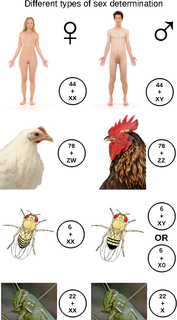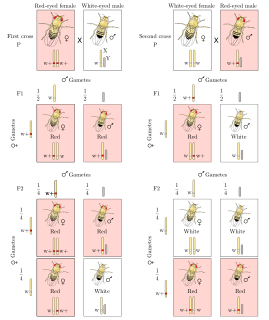Related Research Articles

An autosome is any chromosome that is not a sex chromosome. The members of an autosome pair in a diploid cell have the same morphology, unlike those in allosome pairs which may have different structures. The DNA in autosomes is collectively known as atDNA or auDNA.

A chromosome is a long DNA molecule with part or all of the genetic material of an organism. Most eukaryotic chromosomes include packaging proteins called histones which, aided by chaperone proteins, bind to and condense the DNA molecule to maintain its integrity. These chromosomes display a complex three-dimensional structure, which plays a significant role in transcriptional regulation.

A gamete is a haploid cell that fuses with another haploid cell during fertilization in organisms that sexually reproduce and possess only one set of dissimilar chromosomes. Gametes are an organism’s reproductive cells, also referred to as sex cells. In species that produce two morphologically distinct types of gametes, and in which each individual produces only one type, a female is any individual that produces the larger type of gamete—called an ovum— and a male produces the smaller tadpole-like type—called a sperm. Sperm cells or spermatozoon are small and motile due to the flagellum, a tail-shaped structure that allows the cell to propel and move. In contrast, each egg cell or ovum is relatively large and non-motile. In short a gamete is an egg cell or a sperm. Ova mature in the ovaries of females and sperm develop in the testes of males. During fertilization, a spermatozoon and ovum unite to form a new diploid organism. Gametes carry half the genetic information of an individual, one ploidy of each type, and are created through meiosis, in which a germ cell undergoes two fissions, resulting in the production of four gametes. In biology, the type of gamete one produces determines the classification of their sex.

Organisms of many species are specialized into male and female varieties, each known as a sex. Sexual reproduction involves the combining and mixing of genetic traits: specialized cells known as gametes combine to form offspring that inherit traits from each parent. The gametes produced by an organism define its sex: males produce small gametes while females produce large gametes. Individual organisms which produce both male and female gametes are termed hermaphroditic. Gametes can be identical in form and function, but, in many cases, an asymmetry has evolved such that two different types of gametes (heterogametes) exist.

The XY sex-determination system is a sex-determination system used to classify many mammals, including humans, some insects (Drosophila), some snakes, some fish (guppies), and some plants. In this system, the sex of an individual is determined by a pair of sex chromosomes. Females typically have two of the same kind of sex chromosome (XX), and are called the homogametic sex. Males typically have two different kinds of sex chromosomes (XY), and are called the heterogametic sex.

A sex-determination system is a biological system that determines the development of sexual characteristics in an organism. Most organisms that create their offspring using sexual reproduction have two sexes. Occasionally, there are hermaphrodites in place of one or both sexes. There are also some species that are only one sex due to parthenogenesis, the act of a female reproducing without fertilization.

Karyotyping is the process by which photographs of chromosomes are taken in order to determine the chromosome complement of an individual, including the number of chromosomes and any abnormalities. The term is also used for the complete set of chromosomes in a species or in an individual organism and for a test that detects this complement or measures the number.

The Y chromosome is one of two sex chromosomes (allosomes) in therian mammals, including humans, and many other animals. The other is the X chromosome. Y is normally the sex-determining chromosome in many species, since it is the presence or absence of Y that typically determines the male or female sex of offspring produced in sexual reproduction. In mammals, the Y chromosome contains the gene SRY, which triggers male development. The DNA in the human Y chromosome is composed of about 59 million base pairs. The Y chromosome is passed only from father to son. With a 30% difference between humans and chimpanzees, the Y chromosome is one of the fastest-evolving parts of the human genome. The human Y chromosome carries an estimated 100-200 genes, with between 45 and 73 of these protein-coding. All single-copy Y-linked genes are hemizygous except in cases of aneuploidy such as XYY syndrome or XXYY syndrome.
Haldane's rule is an observation about the early stage of speciation, formulated in 1922 by the British evolutionary biologist J.B.S. Haldane, that states that if in a species hybrid only one sex is inviable or sterile, that sex is more likely to be the heterogametic sex. The heterogametic sex is the one with two different sex chromosomes; in therian mammals, for example, this is the male.

Sex linkage describes the sex-specific patterns of inheritance and presentation when a gene mutation (allele) is present on a sex chromosome (allosome) rather than a non-sex chromosome (autosome). In humans, these are termed X-linked recessive, X-linked dominant and Y-linked. The inheritance and presentation of all three differ depending on the sex of both the parent and the child. This makes them characteristically different from autosomal dominance and recessiveness.

Dosage compensation is the process by which organisms equalize the expression of genes between members of different biological sexes. Across species, different sexes are often characterized by different types and numbers of sex chromosomes. In order to neutralize the large difference in gene dosage produced by differing numbers of sex chromosomes among the sexes, various evolutionary branches have acquired various methods to equalize gene expression among the sexes. Because sex chromosomes contain different numbers of genes, different species of organisms have developed different mechanisms to cope with this inequality. Replicating the actual gene is impossible; thus organisms instead equalize the expression from each gene. For example, in humans, females (XX) silence the transcription of one X chromosome of each pair, and transcribe all information from the other, expressed X chromosome. Thus, human females have the same number of expressed X-linked genes as do human males (XY), both sexes having essentially one X chromosome per cell, from which to transcribe and express genes.

X hyperactivation refers to the process in Drosophila by which genes on the X chromosome in male flies become twice as active as genes on the X chromosome in female flies.

Haplodiploidy is a sex-determination system in which males develop from unfertilized eggs and are haploid, and females develop from fertilized eggs and are diploid. Haplodiploidy is sometimes called arrhenotoky.
The mechanisms of reproductive isolation are a collection of evolutionary mechanisms, behaviors and physiological processes critical for speciation. They prevent members of different species from producing offspring, or ensure that any offspring are sterile. These barriers maintain the integrity of a species by reducing gene flow between related species.
A metafemale is a low viability Drosophila fruit fly with a female phenotype in which the ratio of X chromosomes to sets of autosomes (A) exceeds 1.0. For example: a fly with one X chromosome and two sets of autosomes is a normal male, a fly with two X chromosomes and two sets of autosomes is a normal female, and a fly with three X chromosomes and two sets of autosomes is a metafemale.
Heterogametic sex refers to the sex of a species in which the sex chromosomes are not the same. For example, in humans, males, with an X and a Y sex chromosome, would be referred to as the heterogametic sex, and females having two X sex chromosomes would be referred to as the homogametic sex.
A metamale is a low viability Drosophila fruit fly with a male phenotype in which the ratio of X chromosomes to sets of autosomes (A) is less than 0.5. For example: a fly with one X chromosome and two sets of autosomes is a normal male, a fly with one X chromosome and three sets of autosomes is a metamale.

A sex chromosome, is a chromosome that differs from an ordinary autosome in form, size, and behavior. The human sex chromosomes, a typical pair of mammal allosomes, determine the sex of an individual created in sexual reproduction. Autosomes differ from allosomes because autosomes appear in pairs whose members have the same form but differ from other pairs in a diploid cell, whereas members of an allosome pair may differ from one another and thereby determine sex.
The concept of a biological species as a group of organisms capable of interbreeding to produce viable offspring dates back to at least the 18th century, although it is often associated today with Ernst Mayr. Species of the fruit-fly Drosophila are one of the most commonly used organisms in evolutionary research, and have been used to test many theories related to the evolution of species. The genus Drosophila comprises numerous species that have varying degrees of premating and postmating isolation between them. These species are useful for testing hypotheses of the reproductive mechanisms underlying speciation.

Silene is a flowering plant genus that has evolved a dioecious reproductive system. This is made possible through heteromorphic sex chromosomes expressed as XY. Silene recently evolved sex chromosomes 5-10 million years ago and are widely used by geneticists and biologists to study the mechanisms of sex determination since they are one of only 39 species across 14 families of angiosperm that possess sex-determining genes. Silene are studied because of their ability to produce offspring with a plethora of reproductive systems. The common inference drawn from such studies is that the sex of the offspring is determined by the Y chromosome.
References
- Gilbert, Scott F. (2000). Developmental Biology (6th ed.). Sinauer Associates. ISBN 9780878932436.
- Meurant, Gerard (1990). Wright, Theodore R.F. (ed.). Advances in Genetics. 27. Academic Press. ISBN 0120176270. LCCN 47-30313.
| | This genetics article is a stub. You can help Wikipedia by expanding it. |
| | This article related to members of the fly family Drosophilidae is a stub. You can help Wikipedia by expanding it. |